Production stills by Paul Bednall Photography, except where otherwise indicated.
Behind-the-scenes stills by Paul Bednall, Sophie Black, Philip Briggs, Tommy Draper, Steve Giller and Katie Lake.
Blog posts from when Neil used to produce and direct his own micro-budget movies (2001-2014).
Production stills by Paul Bednall Photography, except where otherwise indicated.
Behind-the-scenes stills by Paul Bednall, Sophie Black, Philip Briggs, Tommy Draper, Steve Giller and Katie Lake.

For independent filmmakers, there was a time when trailers were something you didn’t worry about until the movie was finished and you were looking to get it distributed. Maybe you cut a basic one during or just after production to show the cast and crew some of the fruits of their hard work. (This proved a massive morale booster during Soul Searcher‘s six-week principal photography slog.)
But times have changed. Now the saturation of broadband has made video on the web an everyday thing, and a trailer for your short film or micro-budget feature posted on-line has a good chance of reaching some kind of audience and starting to build word of mouth about your project. Not to mention the rise of crowd-funding, for which having a pitch video – typically consisting partly of a trailer – is essential. Indeed, shooting a trailer before you’ve shot the film, in order to raise finance, has become extremely common.
So today I’m going to share some advice on editing trailers. I can’t claim to be an expert on trailer editing – it’s not an area of editing I’ve ever been able to specialise in – but the trailers I’ve cut generally get a good reaction, so I must be doing something right.
By the way, these tips assume that you’ve actually shot the film. If not, you’re more in the area of a teaser trailer, which is a whole other subject.
The first trailer I cut for Soul Searcher – the morale-booster – used Mark Mancina’s theme from Speed. Since it was just for cast and crew and wasn’t going on the internet, the copyright thing wasn’t an issue. But these days you’ll definitely want to put your trailer online, so make sure you have the rights to use the music.
If you already have a composer lined up for your film, it may seem logical to have them score your trailer. This is what I did for Soul Searcher’s second trailer, edited primarily for a preview screening at 2004’s Borderlines Film Festival. Unfortunately this didn’t really work. The composer dutifully reflected every little change in the on-screen action. But that’s not how trailer music works. Trailer music needs to be driving and insistent, and should only change moods at two or three carefully planned points. So here’s the tip:
ALWAYS CUT YOUR TRAILER TO MUSIC. Never edit first and try to add music later or have music written to fit.
Watch the Dark Shadows trailer and notice how they use music to pace the edit and underline the transitions. Also note how they punctuate the comedy by stopping the music for the bigs gags, then bring it back in over a reaction shot.
Everything you need to know about how to edit a trailer can be learnt from simply watching trailers. You’ll notice that they’re structured into well-defined acts, with a key plot point and a change in the music between each act. Like an actual film, the first act will normally set up the world and characters, the second will present a sticky situation and the third will be about trying to resolve that situation, although of course in a trailer no resolution will come.
These days the studio logos tend to be a few shots in, or even at the start of the second act. If you don’t have a motion graphic logo for your production company, now’s the time to sort one out because it won’t feel like a trailer without it.
At the end of the third act will be the title and the “button”. This is a final beat – a sort of exclamation mark at the end of the trailer’s sentence – and is usually comedic. That’s followed by a couple of brief screens of credits (SFMoviePoster is a useful font to get hold of here) and a release date.
Look at the structure in The Dicator’s trailer below: a prelude building mystery, a first act setting up the character, a second act showing the kidnapping predicament, and a third act in which hilarity ensues. Possibly.
Two stylistic things that have been pretty big in trailers for a few years are speed changes and lines over black.
Speed changes work best on tracking or craning shots, and quite simply involve speeding up the first part of the shot for no other reason that it looks kind of cool. Slow motion is used a lot as well, often because you need to emphasise a dramatic point in the trailer more than the director felt was necessary for the film itself. For the same reason, adding a digital zoom-in to a key close-up is quite common.
Running lines of dialogue over a black screen is another emphasis tool. Typically these come at the transition points between acts. We get a montage of shots and music, then everything goes black and silent except for one key line of dialogue, then – BOOM! – a new piece of music kicks in and we’re assailed with moving images once again.
Similarly, fades to black get used a lot in trailers. These can help hide continuity issues caused when you compress a scene, but also aid generally in pacing.
Strobing has become popular lately too – cutting black frames into shots to break them up. It adds pace and makes the viewer feel like they’re not getting to see everything. See the end of this Prometheus trailer for an example.
Keep these to a minimum. In fact, don’t do a voiceover at all unless you can afford to hire the actual Trailer Voice Guy. Anyone else voicing over your trailer will immediately make it sound amateurish, unless it makes sense for one of the characters in the film to do the VO.
And don’t put your cast’s names up in big letters in your trailer, unless they’re genuine name actors.
Taglines are fine as on-screen text. Check out trailers for films in a similar genre to help you choose a font. There was a time when every trailer had text which moved towards you, with the letters simultaneously separating out. That fad seems to be over now, but look out for things like this in big movie trailers which you can emulate. Dramas and chick-flicks tend to have their captions over a background of out-of-focus points of light – easy enough to shoot with a DSLR and some Christmas lights if you can’t get hold of a stock motion graphic.
Take This Waltz, below, uses this kind of text background.
Sound is just as phenomenally important in a trailer as it is in any other moving image format. Bad sound can instantly ruin all the hard work you’ve put in to make your trailer look like a “real” trailer.
It can be difficult, especially if you’re cutting your trailer early in post-production. You haven’t done your ADR yet and you don’t even have a post-production sound crew on board.
The solution? Download Audacity – a free piece of audio editing software – and use its noise removal filter on any troublesome production sound. It won’t work miracles, but if you have background noise like traffic, hiss or mains hum it will seriously reduce it. As a side effect you will get digital artefacts, but these will be inaudible once you’ve mixed in your music.
Make judicious use of good sound effects. Get hold of some nice, chunky whooshes to underscore your speed-changes, or your captions zooming on. If your film is a comedy, maybe throw in a record scratch effect when your music jars to a halt for an act change.
Check out the use of loud, whooshy, slammy noises (technical term) in the Men in Black III trailer:
In case you somehow missed it, here’s the trailer for my new short film, Stop/Eject:
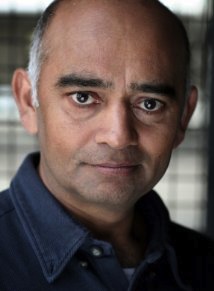
This is Bhasker Patel. Yes, he’s that guy from off of Eastenders.
Last autumn, when I posted the first casting call for Stop/Eject, Bhasker applied. At the time I envisaged the Shopkeeper as a little old man, so Bhasker fit the bill and I invited him to audition. He said he couldn’t make it because he was needed on the set of Eastenders.
Later I put out a call for Dan, aged 25-35. Bhasker applied again.
Then I put out a call for Old Kate, an elderly woman. Once again, Bhasker applied.
In fact, every casting call I put out for Stop/Eject (and I put out a lot, because as you know we had horrendous trouble getting – and keeping – a cast) Bhasker applied to.
This is a waste of my time and his. You apply for a role, it turns out you can’t make the audition – fine, could happen to anyone. You apply for a role you’re clearly unsuitable for – definitely comes across as desperate, but worse things have happened. You apply multiple times to the same film for roles you don’t fit when you know you probably don’t have time to audition anyway – clearly you’re not actually reading the breakdowns.
And he’s not the only one. Don’t even get me started on composers, many of whom seem to spend far more time writing spam than music. (Sorry to those composers I actually work with. You are lovely. Don’t ever change.)
Rant over.
Actually, those puppy-dog eyes staring out at me from Bhasker’s headshot make me feel like quite an arse for bashing him. Sorry dude. You’re probably quite a nice guy. Maybe someone hacked your email account? You should look into that.
A look at the unscheduled sixth day of principal photography on Stop/Eject…
For Stop/Eject’s post-production crowd-funding campaign, we’ve introduced a new idea. As well as individual rewards for everyone who sponsors – anything from a ticket to the premiere to a voice role in the film, depending on how much you contribute – there are public rewards too. The way these work is that every time the total raised passes one of the hundred pound marks, we release a little treat online – like podcasts or special blog posts.
When the campaign was launched yesterday, we received an amazing £240 in just a few hours, smashing through the first two public reward targets.
Accordingly, Sophie has published a special, detailed blog breaking down the design and creation of the living room set, and a video podcast about the final day of shooting. Why the final day? Well, because the podcasts about the other days aren’t ready yet; we weren’t expecting the total to get past £200 so quickly!
And you can watch the podcast above.
You can make your contribution to Stop/Eject at stopejectmovie.com and help us reach the next target, £300, for an in-depth breakdown of how I lit the shop scenes, what with and why.
The wait is over – Stop/Eject’s trailer just went live at stopejectmovie.com

Last July when I bought my Canon 600D (Rebel T3i) DSLR I also invested in a Proaim shoulder rig from Cine City. I reviewed the rig on this site soon afterwards, based mainly on playing about with it at home, but although I mentioned briefly how it fared during the Field Trip shoot last August I’ve never got around to giving a proper verdict on how this rig performs in a shoot scenario. Until now.
First and foremost, the rig is designed to give you the kind of smooth(ish) handheld shots you would get from a shoulder-mounted camera – broadcast/ENG, 16mm or whatever. While it certainly does that, all the weight of your DSLR is on the front of the rig, so it very quickly becomes difficult to hold up. You need to add a counterweight to the back – mine being a backpack which I can fill with whatever heavy stuff is to hand, loosely fastening the waist strap to prevent it swinging around. I’ve yet to make any serious use of this set-up, so I’ll have to get back to you on how it works out in the field.
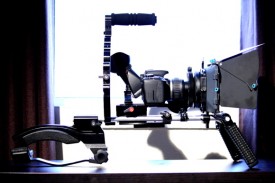
Aside from the shoulder pad, the Proaim rig comprises several other elements which can be fitted onto the core rail system as required. These are:
Prior to Stop/Eject, I generally fitted everything bar the follow focus whenever I used the camera. (Sadly most jobs I do lack the budget for a focus puller, and I don’t find the follow focus useful when pulling by eye.) To be perfectly honest, I did this mainly to make the camera look bigger and more impressive – particularly important on corporate jobs!
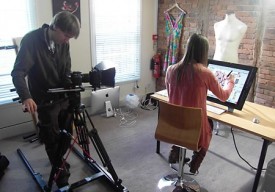
On Stop/Eject there was no time to have unnecessary accessories getting in our way, so I fitted only the follow focus, adding the matte box and sunshades very occasionally to flag a bit of backlight or use a graduated ND filter. Whenever I had to pick the camera up while still on the tripod, I regretted not fitting the top handle, but I never found time to put it on.
So the follow focus was the main part of the rig to get used. And I’m afraid the verdict here is not good. I knew before I bought the rig that many reviewers had complained about the gears having a little play in them. But I also knew that better quality follow focus units were out of my price range, and that some reviewers reported being able to reduce or remove the play by tightening a screw.
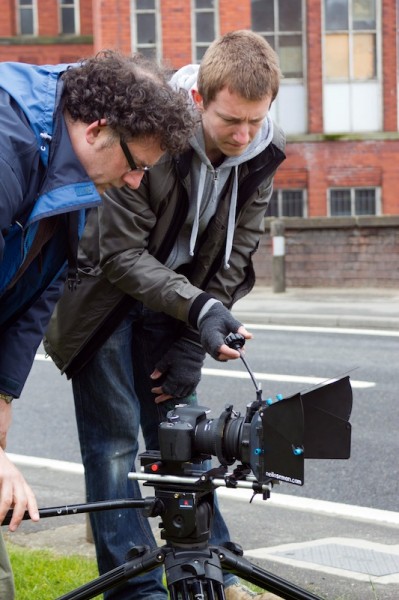
Well, no amount of screw tightening has done the job; there is still play. You can turn the focus knob about a millimetre before the focus ring of the lens starts to rotate. Shooting at f1.8 on my 20mm Sigma lens for a big wide – such as the master shot of the basement – that single millimetre can represent 20 metres of focal distance. Result? I had to pull the focus on that master shot by eye.
Col got skilled enough by the end of the shoot to compensate for this play, but it still caused us problems from time to time. I believe Cine City have now released a version two of their follow focus, so perhaps this is an improvement.
I have to say that the most effective parts of the rig are the matte box and sunshades. Aside from looking impressive, the ease with which you can flag off stray light is brilliant – no more gaffer-taping bits of cardboard to your camera.
But I was surprised to find on Stop/Eject that I was often bypassing the rig altogether and slapping the camera straight on the tripod.
You’ve got to do whatever’s going to get the job done right. I’d definitely advise having this rig in your arsenal, assuming you can’t afford one of the better quality options. With a decent counterweight it will massively improve your handheld shots, and the rest of the bits will come in handy too – just don’t expect to use all of them all of the time.


Historically, the films that I’ve made off my own back have not been money-spinners. The Beacon clawed back only a few hundred of its £3,000 budget, Soul Searcher made money for the distributors but not the investors, and The Dark Side of the Earth‘s hellishly expensive pilot has so far failed to raise any production funding.
But at last one of my films has made a profit. Gasp! Swoon!
Which one? Ironically, the easiest and cheapest to make: The Picnic. Shot in a single day last June for £100 and running to only 140 seconds, The Picnic is about a man who turns up to a romantic picnic only to find his beloved in the arms of another man. You can watch it here.
Although it failed to win any prizes in Virgin Media Shorts, the competition for which it was made, The Picnic found another, completely unexpected source of revenue.
At a networking event late last year, I got talking to a local composer who I’d worked with indirectly several times. He told me that he was involved in writing an exam paper for music students, and that he was on the look-out for a three minute film with little or no dialogue which could be given to said students for them to compose a score to. Naturally I showed him The Picnic, and after a few months of back and forth the exam board purchased the rights to use the film.
Okay, it worked out at only £50 for each of the actors and crew, but since we weren’t expecting anything, it was a nice surprise.
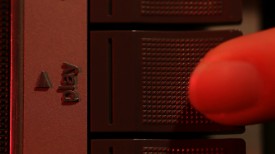
Over the years I’ve developed a bad habit of shooting pick-ups. I really wanted to leave Derbyshire on April 26th with the whole of Stop/Eject in the can, but sadly it was not to be. 25 close-ups of the tape recorder which were scheduled for filming with a skeleton crew on that final day were pushed aside to make way for the weir shots dropped earlier in production.
I grabbed three or four of these close-ups while we were packing up at Magpie, but the rest would have to be shot in my living room back in Hereford.
Which is what I spent most of yesterday doing, with my long-suffering wife Katie standing in for the leading lady once again.

Although it took longer than it would have done with a couple of extra crew and a bit more space, it was incredibly useful to have my iMac right there with all the footage from principal photography on it – some of it even roughly assembled – so we could make sure the lighting and hand movements matched perfectly.
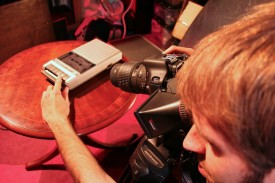
Almost every pick-up was shot with a Sigma EX 105mm macro lens which I bought on eBay a few weeks ago. This is a fantastic lens with a huge focusing range which enabled me to get big close-ups of individual buttons on the recorder.
It’s weird shooting things that tight because you start to worry about stuff that’s not normally visible, like tiny bits of dry skin on people’s hands and miniscule dents in things. When you think about what size of screen the film might be projected on at a festival it’s possible to become picky to a crippling degree.

For a few specific shots, where bad things are going on in the story, I switched out the Sigma for a Canon zoom and fitted a cheap macro adapter on the front. This gave me soft focus, blooming on the highlights and colour aberration around the edges of frame. I love to do optical stuff like this in-camera wherever I can, rather than relying on post-production effects which can often look cheesy.
Anyway, the shots were all accomplished successfully, despite the fact that the hero tape recorder had a fault and wouldn’t play for more than a couple of seconds before grinding to a halt. For extreme close-ups on the rotating capstans and the playhead moving into position I used a children’s tape player bought from a charity shop last year (for the opening shots of the Stop/Eject podcasts) from which I’d removed the cassette door.

A couple of shots were storyboarded as being top-down from directly above the table. To save rigging up the camera on a C-stand, I laid the table on its side and blu-tacked the recorder and tapes to it.
Annoying as they are, I advise you to always expect there will be pick-ups to shoot (maybe right after principal photography, maybe only a couple of weeks before the premiere) and plan accordingly, i.e. keep as much stuff from the shoot as you possibly can, particularly…
Of course pick-ups aren’t always because you dropped stuff during principal photography. Often they’re new material that you realise you need as the edit develops. It’s too early to say whether Stop/Eject will have any of those. Either way, there is still one more storyboarded shot to film – of a microwave. Which sounds simple, but it’s not. More on that another time.

Everyone on the cast and crew probably wanted to kill me because of the schedule. The days were too long and the turnaround times were too short. But let’s look at how the schedule developed in pre-production and how it turned out in practice.
Before we begin, some basic info. The script is 19 pages long, so theoretically 19 minutes. There are 31 scenes, 11 story days and 14 locations. Yeah, in a nutshell, ridiculous for a short film.
Six of the locations we found in one building: Magpie, in Matlock. Most of the remaining ones were in Belper, 11 miles down the road.
When we were going to shoot last October, it was a four-and-a-half day schedule. The first half day we would have been without the lead actress (who is in almost every scene) and the last half day we would have been without anyone except a skeleton crew, for shooting close-ups of the tape recorder.
When the project got up and running again this year, I immediately increased the schedule to five days. I had been really freaked out in October about getting it all shot in essentially just four.
Initially I wanted to shoot Monday-Friday, since weekdays seemed most convenient for the locations, but the two lead actors we had at the time both temped during the week and wanted to do as much as possible at the weekend, so I went with Saturday-Wednesday. (Ironically, it would have better suited Georgie, who ultimately played the lead role, if we had shot Monday-Friday.)
Remember that the first and foremost goal of your schedule is to minimise the number of location moves, because they waste phenomenal amounts of time. (A common mistake is to consider only the driving time between locations and overlook the time it takes to derig all the equipment, pack it into the vehicles, unpack it and set it up again at the other end. And don’t forget that at least one of your vehicles will probably get lost during the location move, so budget in time for that as well.)

I knew that those of us who weren’t local to the area could stay at Magpie, and that we could also stay at Sophie’s in Belper from the third day onwards. So the most logical schedule was to shoot all the Magpie stuff Saturday-Monday, then move to Belper on Monday night and shoot everything there on Tuesday and Wednesday.
This was all well and good until Georgie was cast a week before the shoot, and she had a prior commitment in London on Sunday morning. This meant we would lose her at 7pm on Saturday and not get her back for 24 hours.
There was approximately a day’s worth of material that could be shot without her, but half of that consisted of tape recorder close-ups that couldn’t be filmed until we had her master shots to match them to, master shots from various locations that couldn’t possibly all be shot on Saturday. So it was clear that Sunday’s schedule would be pretty sparse until Georgie returned at 7pm, shooting just the Businessman scenes in Belper. The half-day of tape recorder close-ups would have to wait until Thursday, extending the schedule.
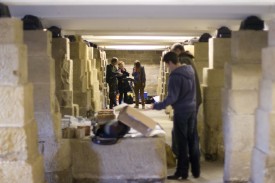
The other fixed point I was working around was the basement location (in Belper), which was only available on the Tuesday. This prevented me from simply flipping the schedule and doing all the Belper stuff first, then the Magpie stuff.
Two full days of shooting would take place on the shop floor of Magpie, and it was essential that those were consecutive so that we wouldn’t have to restore the shop and then redress it again later. Given the availability of Georgie and the basement, the only solid two-day stretch was from Sunday evening through to Tuesday lunchtime, which even then isn’t a full two days. So that’s where the shop floor had to go, and the rest of the schedule just had to fit around it.
Since many of us would be staying at Magpie over the weekend, I was keen to do as much filming there as possible during that time, so I scheduled in the living room, bedroom and nursing home scenes for Saturday. But then I realised that this left the major exterior scenes nowhere to go except Wednesday – the last day of the shoot. If the weather was bad, we would have nowhere left to postpone them to.
So the living room, bedroom and nursing home got moved to Wednesday and the exteriors slotted in on Saturday, with the proviso that they would be swapped back if Saturday was rainy.
I had arrived at a final schedule, which looked like this:
As you can see, there are some tight turnarounds, particularly during the shop floor stuff in the middle of the schedule. This was partly a result of squeezing two days of shop floor material into one full day, one morning and one evening. It was also difficult to balance conflicting things like the need to wait for it to get dark at the end of the day to shoot some scenes, but also needing to get up early enough in the morning to film exteriors outside the shop when the road wasn’t too busy.
I definitely felt like I was fighting the clock throughout the shoot.
We wrapped more or less on time on Saturday, but had dropped the sun GVs and a crucial wide shot for the weir scene.
On Sunday things kept to schedule until the evening, when we overran and wrapped about 75 minutes late.
We wrapped most of the cast and crew slightly later than the anticipated time of 10:30pm on Monday, but Colin and I cracked through the cutaways and wrapped the day overall a few minutes early.
On Tuesday we finished at Magpie at noon, not 11am, but made up some of the time on the location move (which almost never happens) and got to the basement only half an hour late. We wrapped there still about 30 minutes behind, but made up the time at the cemetery. Then we got ahead of schedule by changing the bridge shot (scene 15) from night to day, thus saving an hour of setting up lights, and were able to retire to Sophie’s and get the kitchen scene in a very relaxed fashion.

Wednesday was without a doubt the toughest day. Although the living room, the bedroom, the nursing home and the alcove set were all in the same building, moving between them still took time, and since we were all fatigued it was like wading through treacle. By lunchtime we were two hours behind and this only got worse as we moved onto the critical alcove scenes after dinner. It must have been getting on for 3am by the time we wrapped.
Thursday turned out very differently to what we’d planned. Fortunately Georgie and Ollie were both available to pick up the weir wide shots. We started late because everyone was so knackered, and couldn’t shoot at the first location we visited (due to heavy rainfall swelling the river), so had to move to another one. We finally got the two shots in the can by about 3pm, and decided to leave most of the planned tape recorder close-ups to another time. (I’ll be shooting them here in Hereford next week.)
I’ll discuss why we kept falling behind schedule in a future post, but I’d like to end on a cautionary note. Not allowing sufficient turnaround time is a vicious circle. I hated the mornings on the shoot because I could see that people weren’t getting up fast enough to get out of the door at the necessary time. I couldn’t hassle them because they’d been up late the previous night and were understandably very tired, but I knew that by starting late we would end up finishing late again and the cycle would continue.
The only way to lengthen the turnaround time would have been to have added another day to the schedule, and this of course brings its own problems in the form of increased costs and people’s availability. This is why making unpaid short films will always be a messy, unpleasant business and if you’re at all rational you’d do well to avoid such shoots like the plague.
But where’s the fun in that?

It’s high time we heard from producer and production designer Sophie Black on this blog, so here are her thoughts on the pre-production of Stop/Eject.
Four days ago we wrapped on Stop/Eject after a six day shoot that felt like a month. There were stressful bits, and no one got much sleep. But it was also one of the best shoots of my life!
The footage is looking amazing (keep checking the Stop/Eject Facebook Page for all the stills as they come online) and I can’t wait for the trailer. This shoot, without a second’s thought, goes straight into my top two, and not just because I finally got to stay at home and film on my doorstep. My only problem now is that I’ve gone from working all day every day for about two months to an empty house and nothing on my immediate schedule. Cold turkey. So I’ve promised director Neil Oseman that I would start doing a series of guest blogs, and I hope that these will cure me of my Stop/Eject withdrawal symptoms.
Today I’m talking about pre-production in the Art Department, and for that I need to take us back to this time two weeks ago. Now, with all independent films – and particularly with short films – it’s to be expected that tasks will have to be shared out, and that job boundaries will get blurred as it’s all hands on deck. It is for that reason that two of the main set builders on all Light Films projects are the director and the writer, and that the catering on Stop/Eject was covered by the costume designer and the make-up artist.
So you expect to have to do work out of your job description. What you don’t always predict, however, is the workload that’s caused by drop-outs.
Two weeks before the Stop/Eject shoot, I had a pretty long list of work left to do. I was juggling the Ashes prep with last minute S/E casting, two rooms to paint and dress, a couple of props to finish, and over 400 tape cassettes to do calligraphy on (urgh!). Not an ideal amount of work with two weeks left to go, but achievable.
The first task was re-doing part of a gravestone set piece. Many things were rushed the first time we went to make Stop/Eject, and I’d had to make do with my first attempt, which was decent but a little untidy (first image below). The good thing about having to push back the shoot – although it was disappointing at the time – was the fact that we got to do everything a hundred times better. The gravestone was certainly one of those things.
To help me improve it, Neil got in contact with professional production designer Ian Tomlinson, who told me that I could get a neater finish on the lettering if I printed out a stencil then engraved it into foamboard. (I’d used polystyrene for the rest, which still made good stone).
After I stuck the foamboard over the original lettering, I spray-painted it with the same stone effect spray as before, left it to dry in my downstairs loo (there was nowhere else to put it!) then used a dry-brush in a darker colour to add ageing and definition to the lettering.
That went smoothly, and I managed to get the location painting done in one afternoon thanks to the help of a volunteer called Ellie Ragdale:
When you’re doing a job which isn’t paid, no matter how great the project, there’s always going to be someone who abandons it in favour of a wage. You can expect one or two at least. And when this happens, no matter how much you have on or how last minute it is, you can’t just turn round to the director on the day and say, “such and such isn’t here because the person dropped out,” or, “it wasn’t my job so I decided to put my feet up and ignore it”. Particularly when it’s part of your department (I was head of Production Design so anything to do with the decoration was supposed to be in my control). It can’t just be abandoned when the film needs it. Someone has to do it. And, much as I dreaded it, I knew it would have to be me. There was less than a week until the crew arrived and everyone was already juggling more than their fair share of jobs. I just had to crack on.

The first extra job I took on was the shop sign for the film’s main location. Because of the nature of my job I find it hard to trust helpers, and I rarely delegate on smaller tasks, but I knew a local craftswoman who made beautiful vintage signs so I asked her to do it. She would be paid, but she offered to do it for next to nothing, and I knew she would do a great job. Then I got a call saying that she’d had to go into hospital and wasn’t taking on anymore work.
This one certainly wasn’t anyone’s fault, and it wasn’t too huge a task, so I grabbed by brother’s old warhammer board and a paintbrush and made the sign. It was easy but it was frustrating because I knew that I wasn’t the best person for the job and, due to the other woman’s calibre, what I turned out could only be second-rate.

The next problem came when it was time to build the film’s all-important alcove set. We’d advertised for a builder and had a decent amount of replies, but some weren’t qualified, some didn’t respond to our replies, and others showed genuine interest in the job and sent us a couple of emails, then changed their minds. I managed to contact a few local people I knew and had a few offer to build it with my help, but out of them a few were busy on the day and a couple became oddly aloof and stopped replying to me. The only person left to help managed to stay long enough to help me fetch the materials I needed (thanks Steve!) but had to go at lunchtime due to a prior commitment.This left me, alone in my Dad’s cramped garage (moving into the kitchen for space when needed), with his power tools at hand but no will or clue. I’d only ever decorated a set before; I was trained to design them, even technically, but I’d never wielded an electric saw in my life!
But what I’ve learnt is that it’s amazing what you can do when you try. Luckily I only had to build a wooden box-type thing – albeit ones with panels made out of antique doors – and it wasn’t anything more complicated than that. Plus my Dad helped speed things up by cutting a few pieces after I’d measured and marked them.
Was that the last of the drop-outs? Of course not. We were supposed to have someone build us an ornate, carved wooden arch to go at the front of the alcove set. I’d given the guy the job then he’d sent me a quick concept sketch and I’d even spoken to him on the phone, where he sounded enthusiastic. With less than a week before the shoot, I called him twice to three times a day. every day, and even left him messages, but I never heard from him again. Although it was disappointing, this was one part of the set we decided we could do without.
Instead of two days, the set ended up taking five, during all of which I was thinking about the looming tape cassettes, and wondering when on earth I was going to get them done. My morale was also starting to get pretty low – the garage was cold and I was up until 1am every morning with only Soul Searcher and American Beauty on my laptop to keep me going.
In spite of the odds, by the time the crew arrived there were three completed sides for the alcove, all of which featured heavily-screwed wooden frames, antique doors, and stained hardboard surfaces. Just like that, I’d built my first set.
From that point onwards, I wasn’t alone anymore. The chivalrous Gaffer-turned-handyman Colin Smith built the roof for me, and made sure I had all the pieces I needed to make a basic wooden arch for the front. Then the lead actor Oliver Park joined in too, by staying up with me and helping me paint the last couple of pieces. He even played Aerosmith on his phone to keep me happy. It may be an old-fashioned sentiment, but I think that men are wonderful things!!
Thanks Sophie. I’m off to polish my crocodile shoes, but you can read more about Sophie’s work on her website.